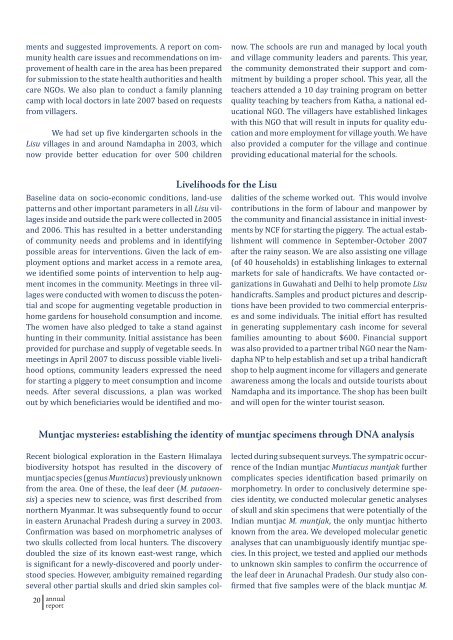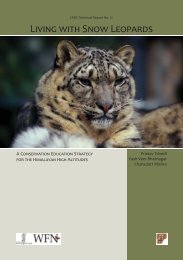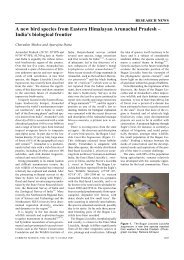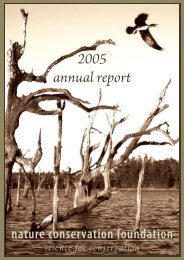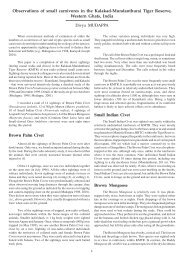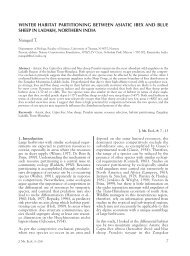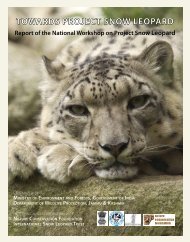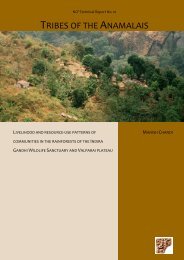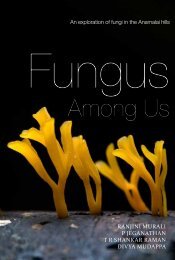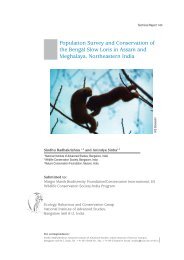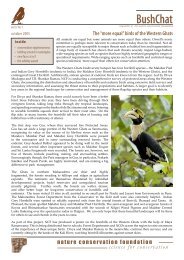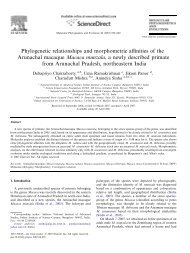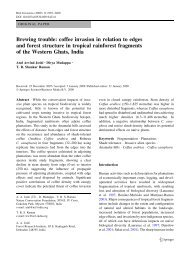2006-7 annual report - Nature Conservation Foundation
2006-7 annual report - Nature Conservation Foundation
2006-7 annual report - Nature Conservation Foundation
You also want an ePaper? Increase the reach of your titles
YUMPU automatically turns print PDFs into web optimized ePapers that Google loves.
ments and suggested improvements. A <strong>report</strong> on community<br />
health care issues and recommendations on improvement<br />
of health care in the area has been prepared<br />
for submission to the state health authorities and health<br />
care NGOs. We also plan to conduct a family planning<br />
camp with local doctors in late 2007 based on requests<br />
from villagers.<br />
We had set up five kindergarten schools in the<br />
Lisu villages in and around Namdapha in 2003, which<br />
now provide better education for over 500 children<br />
now. The schools are run and managed by local youth<br />
and village community leaders and parents. This year,<br />
the community demonstrated their support and commitment<br />
by building a proper school. This year, all the<br />
teachers attended a 10 day training program on better<br />
quality teaching by teachers from Katha, a national educational<br />
NGO. The villagers have established linkages<br />
with this NGO that will result in inputs for quality education<br />
and more employment for village youth. We have<br />
also provided a computer for the village and continue<br />
providing educational material for the schools.<br />
Livelihoods for the Lisu<br />
Baseline data on socio-economic conditions, land-use<br />
patterns and other important parameters in all Lisu villages<br />
inside and outside the park were collected in 2005<br />
and <strong>2006</strong>. This has resulted in a better understanding<br />
of community needs and problems and in identifying<br />
possible areas for interventions. Given the lack of employment<br />
options and market access in a remote area,<br />
we identified some points of intervention to help augment<br />
incomes in the community. Meetings in three villages<br />
were conducted with women to discuss the potential<br />
and scope for augmenting vegetable production in<br />
home gardens for household consumption and income.<br />
The women have also pledged to take a stand against<br />
hunting in their community. Initial assistance has been<br />
provided for purchase and supply of vegetable seeds. In<br />
meetings in April 2007 to discuss possible viable livelihood<br />
options, community leaders expressed the need<br />
for starting a piggery to meet consumption and income<br />
needs. After several discussions, a plan was worked<br />
out by which beneficiaries would be identified and modalities<br />
of the scheme worked out. This would involve<br />
contributions in the form of labour and manpower by<br />
the community and financial assistance in initial investments<br />
by NCF for starting the piggery. The actual establishment<br />
will commence in September-October 2007<br />
after the rainy season. We are also assisting one village<br />
(of 40 households) in establishing linkages to external<br />
markets for sale of handicrafts. We have contacted organizations<br />
in Guwahati and Delhi to help promote Lisu<br />
handicrafts. Samples and product pictures and descriptions<br />
have been provided to two commercial enterprises<br />
and some individuals. The initial effort has resulted<br />
in generating supplementary cash income for several<br />
families amounting to about $600. Financial support<br />
was also provided to a partner tribal NGO near the Namdapha<br />
NP to help establish and set up a tribal handicraft<br />
shop to help augment income for villagers and generate<br />
awareness among the locals and outside tourists about<br />
Namdapha and its importance. The shop has been built<br />
and will open for the winter tourist season.<br />
Muntjac mysteries: establishing the identity of muntjac specimens through DNA analysis<br />
20<br />
<strong>annual</strong><br />
<strong>report</strong><br />
Recent biological exploration in the Eastern Himalaya<br />
biodiversity hotspot has resulted in the discovery of<br />
muntjac species (genus Muntiacus) previously unknown<br />
from the area. One of these, the leaf deer (M. putaoensis)<br />
a species new to science, was first described from<br />
northern Myanmar. It was subsequently found to occur<br />
in eastern Arunachal Pradesh during a survey in 2003.<br />
Confirmation was based on morphometric analyses of<br />
two skulls collected from local hunters. The discovery<br />
doubled the size of its known east-west range, which<br />
is significant for a newly-discovered and poorly understood<br />
species. However, ambiguity remained regarding<br />
several other partial skulls and dried skin samples collected<br />
during subsequent surveys. The sympatric occurrence<br />
of the Indian muntjac Muntiacus muntjak further<br />
complicates species identification based primarily on<br />
morphometry. In order to conclusively determine species<br />
identity, we conducted molecular genetic analyses<br />
of skull and skin specimens that were potentially of the<br />
Indian muntjac M. muntjak, the only muntjac hitherto<br />
known from the area. We developed molecular genetic<br />
analyses that can unambiguously identify muntjac species.<br />
In this project, we tested and applied our methods<br />
to unknown skin samples to confirm the occurrence of<br />
the leaf deer in Arunachal Pradesh. Our study also confirmed<br />
that five samples were of the black muntjac M.


